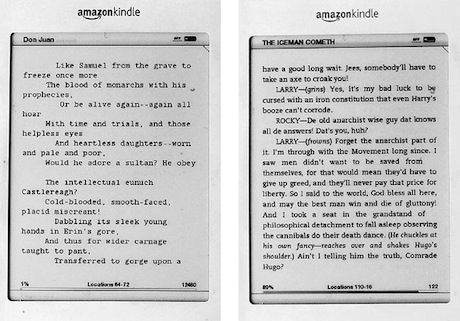Brave New World: E-Book Edition
As this morning's AP story showed, Billy Collins is one of many poets distressed to see his line breaks butchered by the Kindle. Like many poets and their readers, Collins found that the technology isn’t up to snuff when it comes to displaying poetry’s line breaks and spacing. According Collins, e-readers futz with the flow, detracting from the overall poetry reading experience.
So what do others have to say about the dysfunctional relationship between poetry and e-readers? Here’s the latest consensus from tech savvy poetry lovers on two popular devices:
Kindle:
Various bloggers commented on Kindle’s sub-par capacity for poetry; major glitches include slow-loading poetry PDFs, line break splicing and dicing, and a limited online poetry selection. Poetry on a Kindle is “scrambled worse than a Denver omelet,” according to one disgruntled blogger:
I'm a poetry person. I've looked and looked on Amazon.com's "Kindle Store," and their poetry offerings are awful, mostly high profile publications such as Jorie Graham's Sea Change (2008) and Kay Ryan's The Best of It (2010). E-book vendors appear to be in no rush to make available the full range of verse out there. Their negligence extends to how books are digitized, too . . .
Charles McGrath pointed all this out last year in his Kindle write-up for the New York Times, saying the thing was not ideal for poetry but not a total waste of time.
The iPad:
The jury is still out on this one, but Josh Corey finds the popular product an “ideal” medium for reading electronic poetry and accessing PDFs. While reading poetry books via the ibook app still isn’t great, the smooth scrolling and vertical orientation of electronic poetry feels more natural than reading it on the web.:
The iBooks app is, at present, hopeless with poetry: when I downloaded a sample of John Ashbery's Notes from the Air all the lines were inexplicably double spaced. A program like iBooks is premised upon the fungibility of prose: each "page" of the book you're reading is subject to radical transformation based on the orientation of the iPad (a single big page like that of a hardcover or two smaller pages like those of a paperback) and the size of the font you choose (this also increases or decreases the number of "pages") . . .
The Nook:
Also, on the Twitter, Reb Livingston @notell has been talking about her e-reader experience, which so far seems a bit mixed.
Copyright:
Beyond the formatting issues, there’s a different sort e-reader issue affected poets: copyright law. The Guardian has reported on E-book deals that lock writers in and give publishers electronic rights over their work have resulted in authors getting the short end of the stick :
Speaking at the Romantic Novelists' Association's annual conference last week, Holland urged authors to push for ebook royalties that are "considerably higher" than the standard of around 25%. Although Holland said the market for ebooks is only about 1% of the total UK market, it is "growing fast" and the Society of Authors believes that, given publishers will eventually have much lower warehousing and distribution costs for ebooks, royalties should be divided 50/50 . . .
This all will become more and more relevant as publishers sign up with Bookmobile to have their books converted to e-reader friendly formats:
Simply furnish print files or printed books for 1 to 1,000 titles to BookMobile and we'll turn them into high quality ebooks in the major formats. We focus on quality: making sure consumers won't question the value of your product because of all-too-common shoddy formatting.
UPDATE: For anyone who wants to try to figure out how to do all of this formatting him/herself, here are some Advanced Poetry XML tips:
Poetry books consists of poems which are a grouping of title information, metadata, one or more stanzas, and any general commentary and note bodystyles that may be required to present line notes, stanza notes, poem notes, footnotes, or end notes referenced from a poem.
Unfortunately poetry editors and commentators are an unruly lot who insist--from time to time--in adding line notes (referenced from the footer or margin), footnotes, endnotes, commentaries and a lot more. These are all structures that must be able to be created (in frontlist publishing) or tagged in backlist poetry. In both cases for multiple reuse strategies . . .



